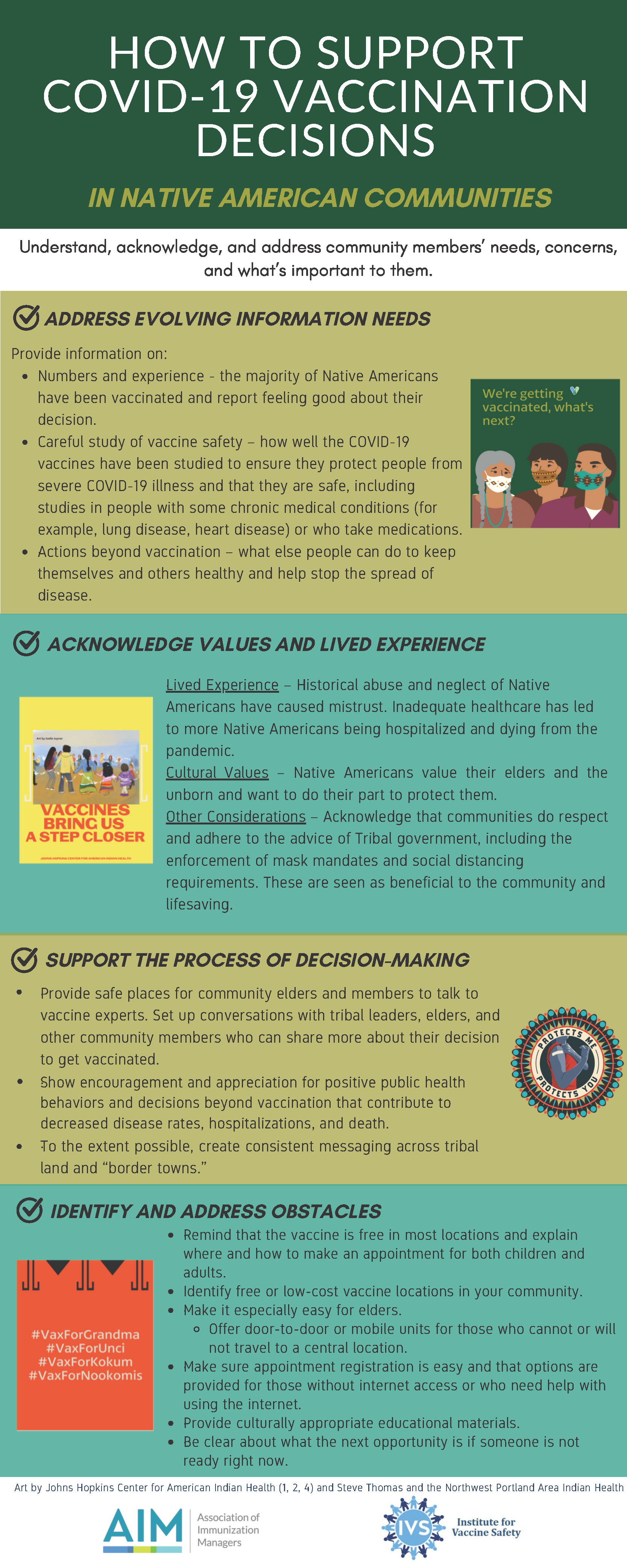How to Support Vaccination Decisions in Native American Communities
Understand, acknowledge, and address community members’ needs, concerns, and what’s important to them.
Address Evolving Information Needs
Provide information on:
- Numbers and experience – the majority of Native Americans have been vaccinated and report feeling good about their decision.
- Careful study of vaccine safety – how well the COVID-19 vaccines have been studied to ensure they protect people from severe COVID-19 illness and that they are safe, including studies in people with some chronic medical conditions (for example, lung disease, heart disease) or who take medications.
- Actions beyond vaccination – what else people can do to keep themselves and others healthy and help stop the spread of disease.
Acknowledge Values and Lived Experience
Lived Experience – Historical abuse and neglect of Native Americans have caused mistrust. Inadequate healthcare has led to more Native Americans being hospitalized and dying from the pandemic.
Cultural Values – Native Americans value their elders and the unborn and want to do their part to protect them.
Other Considerations – Acknowledge that communities do respect and adhere to the advice of Tribal government, including the enforcement of mask mandates and social distancing requirements. These are seen as beneficial to the community and lifesaving.
Support the Process of Decision-Making
- Provide safe places for community elders and members to talk to vaccine experts. Set up conversations with tribal leaders, elders, and other community members who can share more about their decision to get vaccinated.
- Show encouragement and appreciation for positive public health behaviors and decisions beyond vaccination that contribute to decreased disease rates, hospitalizations, and death.
- To the extent possible, create consistent messaging across tribal land and “border towns.”
Identify and Address Obstacles
- Remind that the vaccine is free in most locations and explain where and how to make an appointment for both children and adults. Identify free or low-cost vaccine locations in your community.
- Make it especially easy for elders. Offer door-to-door or mobile units for those who cannot or will not travel to a central location.
- Make sure appointment registration is easy and that options are provided for those without internet access or who need help with using the internet.
- Provide culturally appropriate educational materials.
- Be clear about what the next opportunity is if someone is not ready right now.
This project is focused on how public health and other stakeholders can best understand and support decision-making as individuals consider if, and under what conditions, COVID-19 vaccination is right for them. Participants in these conversations were African Americans, Latinx, and Native Americans recruited from local communities or panel survey respondents from four U.S. regions (Northeast, Midwest, South, West) who had indicated that they were undecided about their intent to vaccinate now or in the future against COVID-19. This project is funded by Robert Wood Johnson Foundation and is a collaboration of AIM, NACCHO, Johns Hopkins, and other partners.

